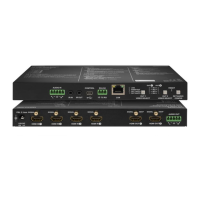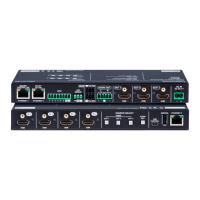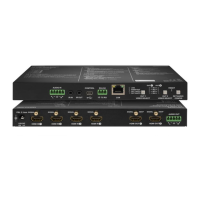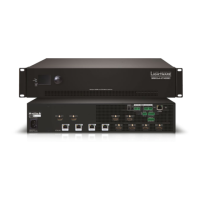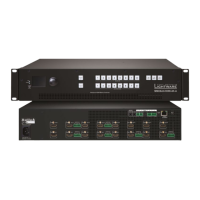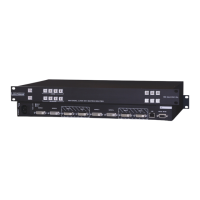Page 76 / 119 Section 8. LW3 Programmers’ reference
8. LW3 Programmers’ reference
8.1. Overview
Lightware 3 (LW3) protocol is used by the 25G hybrid matrix, the MODEX family and the
new series of Lightware TPS products, including the MMX6x2-HT series matrices. The
protocol (LW3) is ASCII-based and all commands are terminated with a carriage return (Cr,
‘\r’) and line feed (Lf, ‘\n’) pair. It is organized as a tree structure that provides outstanding
flexibility for implementing a human readable, but programmatically still ease to parse,
which is suitable for different products with a different feature list.
In order to implement a flexible, easy-to-use protocol that is straightforward to adapt to new
devices and provides outstanding scalability and sustainability, we decided to organize all
settings, parameters and properties of the device to a tree structure with ‘nodes’,
‘properties’ and ‘methods’.
8.1.1. Elements of the tree structure
ATTENTION!
All names and values are case-sensitive. The space character is replaced by the ‘’
character in the elements and commands descriptions.
Node
The basic building block of the tree structure is the ‘node’.
The node can have multiple child nodes, but only one parent.
The tree has only one root the ‘root node’.
The leaves of the tree are also nodes, which do not have child nodes.
The nodes are separated by a slash (‘/’) character.
All the slashes are ‘right slashes’, no backslash is used.
The identifier of the root node is a slash (‘/’)
The node name can contain the elements of the English alphabet and numbers.
Recommended convention for case sensitivity:
- Fix nodes (that cannot be altered) are capitalized.
- User created nodes can contain both lowercase and capital letters, no
restrictions.
The path of a node has to contain all parent nodes from the root node.
Format (the root node): nX/
Path: nX/[nodeName]/[nodeName]/[nodeName]
Legend: ‘n’: node
‘X’ can be:
‘-’: default for a node,
‘m’: this is a manual for the node,
‘E’: this is an error message for the node.
's' this is a symlink node
'v' this node has virtual children
'r' this is a remote node
INFO
All parent nodes must be listed in the path of a node.

